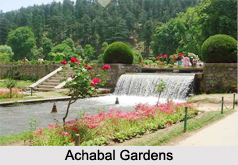 Achabal Garden is one of the most important and splendid tourist places in the state of Jammu and Kashmir and is about 8 kilometres away from Anantnag District of Jammu and Kashmir. Tourism here is the key note, while visiting Jammu and Kashmir.
Achabal Garden is one of the most important and splendid tourist places in the state of Jammu and Kashmir and is about 8 kilometres away from Anantnag District of Jammu and Kashmir. Tourism here is the key note, while visiting Jammu and Kashmir.
Formation of Achabal Garden
It was in the state of Kashmir that the Mughal style gardens were brought to perfection and Achabal Garden is one such masterpiece. This place is famous all over due to an ancient spring surrounded by a terrace garden, which was developed by the Mughal Dynasty in Delhi in the 15th Century to 17th Century. The historical significance of this place strikes the visitor with awe.
Achabal Garden as a Natural Retreat
Achabal Garden was once the pleasure retreat of the Mughal Empress Nur Jahan. It is a beautifully created garden in Jammu and Kashmir with its own special allure and character. Its picturesque beauty makes it one of the best Mughal gardens of the Indian subcontinent. It is difficult to describe in words the mesmerizing beauty of this Mughal style garden. The upper portion of the garden is popularly known as `Bag-e-Begum Abad` and was developed by Malika Noor Jehan Begum in 1620 A.D. Later it became renowned as Sahib Abad in which there was a `Hamam` or treasure of water getting heat from a logical lamp or `tosng`.
Creation of Achabal Garden
Achabal Garden was created at the site of a powerful spring, which enters the garden as a waterfall. The design of this wonderfully created garden is ascribed to the beloved wife of the Mughal Emperor Jahangir.
Background of Achabal Garden
The Garden of Achabal is located at the foot of a hill covered with dense forest which is 8 kilometres from Anantnag and 56 kilometres from Srinagar.
Springs in Achabal Garden
Achabal Garden is also noted for its spring, which is finest place in Jammu and Kashmir and is supposed to be the re-appearance of a portion of the river Bringhi, whose waters suddenly disappear through a large fissure underneath a hill at the village Wani Divalgam in the Brang Pargana. It is said that in order to test this, a quantity of chaff was thrown in the Bringhi River at a place its water disappears at Wani Divalgam and that chaff came out of the Achabal spring. The water of the spring originates from several places near the foot of a low spur which is densely covered with deodar trees and at one place it gushes out from an oblique fissure large enough to admit a man`s body and forms a volume some 18 inches high and about a foot in diameter.
Related Articles
Jammu and Kashmir
Tourism In Jammu And Kashmir
History of India
Medieval History of India
Islamic Architecture
Mughal Architecture
Gardens in Mughal Architecture






